#Hydlide 2
Text
They stealth dropped Hydlide 2 yesterday and I'm gonna be diverging about that for a little bit, that might be my game of the year (1985)
0 notes
Text



Virtual Hydlide is the first and only 3D entry in the Hydlide franchise. Created by T&E Soft, Virtual Hydlide is technically a remake of the first game in the series and is notorious for its poor framerate. This has earned it notoriety as one of the Saturn’s worst games, but it has received reappraisal in recent years and was even speedrun at 2 Games Done Quick events in 2019 and 2024
9 notes
·
View notes
Text

It's been a while since the clouds were normal
Band was good today. I had been wanting to learn Them Bones by Alice in Chains for a while and my uncle just randomly started playing it today so we know it now lol. My brother also brought an extra acoustic out and now I'm learning guitar I guess. I think the main reason he thought to do this was because he needs other parts to play Need 2 by Pinegrove lol. I had kinda been thinking about it too recently but I haven't even been keeping up with hiragana or drawing lately. Not even the games I used to play daily like theatrhythm. It's been a pretty extensive bad brain era that like, re-ups every time I have to drive which is 6 days out of the week minimum
Me and the partner looked at the Pokémon Center website for the first time in a while last night and bro its lookin like a plushie christmas once again. I really need to get a shelf for those thangs cuz I have a giant bin full of them just sitting in my closet and I want to see my little guys
I also watched the GDQ 2020 Super Hydlide run my Mike Uyama and that lead me to a game on Switch called Fairune, which is basically what if Hydlide was good, and it is good, I like it a lot. It's a stark contrast to the other game I was playing yesterday lol. Although the morning after those fucked up Fatum Betula endings I get one thats just a gif of a spinning skeleton and it was really funny, and theres at least 2 or 3 more endings I havent seen, but probably more. I hope there's a few more goofy ones
Barony update for the day is I played Shaman in multiplayer and we're doing alright but that job seems needlessly complex, I love being a rat though. Its basically a shape shifter job but your stat gain is weighted based on what form you are when you level up. So you gotta kinda decide if you want to be magic or physical, but magic sees diminishing returns later on so its weird. I want to love it but I really just love playing Conjurer and not doing anything. Just like in real

Peace and Long Life

4 notes
·
View notes
Text









Motto Atsumare! Falcom Gakuen Vol. 2 - Chapter 14
Figured I might as well upload this to a blog (as backup maybe). The quality is better than the first volume I did because I figured out how to pull images directly from the digital book. It might be a good idea to fix the quality previous chapter in the future... A blog might be better because I can add links in my translation notes, but I will continue uploading them to Mangadex.
Translation Notes
The Isis (イシイス) sticker can be seen here. It was sold as a bonus for snacks, I guess kind of like Kinder Joys that has both food and a toy inside the packaging...
I forgot to include this in the notes, but Toshiro & Eiji (T&E) is the name of the company that made Hydlide game series.
Mayu is a monster from Dragon Slayer IV (Legacy of the Wizard). I found an entry here.
#translations#falcom#falcom academy#motto atsumare! falcom gakuen#dragon slayer#xanadu#tokyo xanadu#ys#trails
1 note
·
View note
Video
youtube
ハイドライドII for MSX(HYDLIDE II / 80's Japanese old pc game)
初めて買ったパソコンゲーム!
クリアまで2年かかったのも懐かしい。(ブラックオニキスの場所が分かりづらい!)
1 note
·
View note
Photo
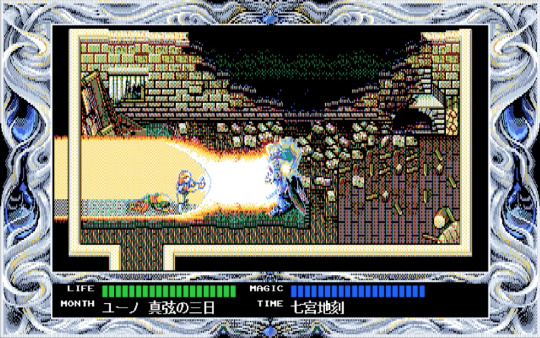
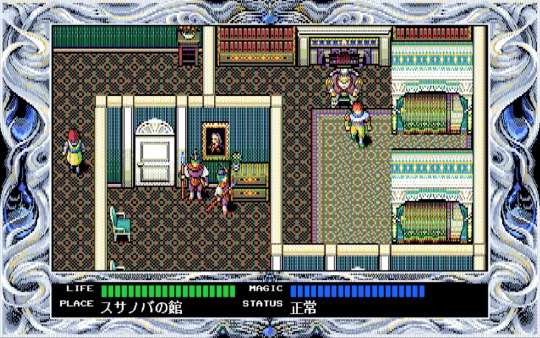

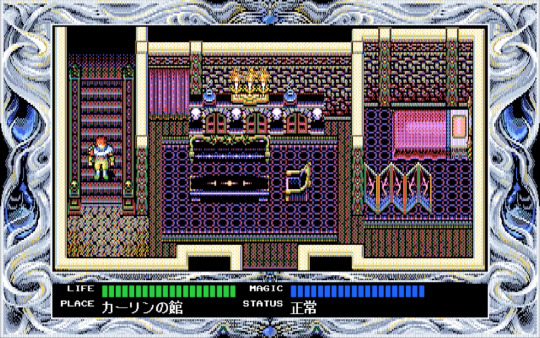
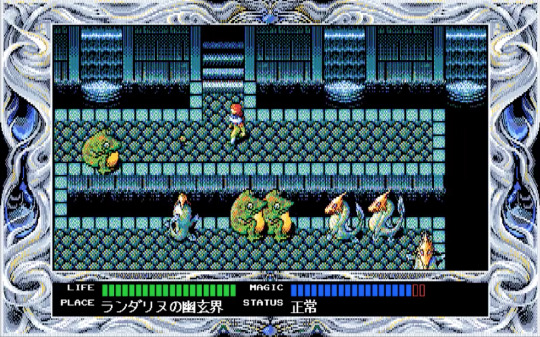

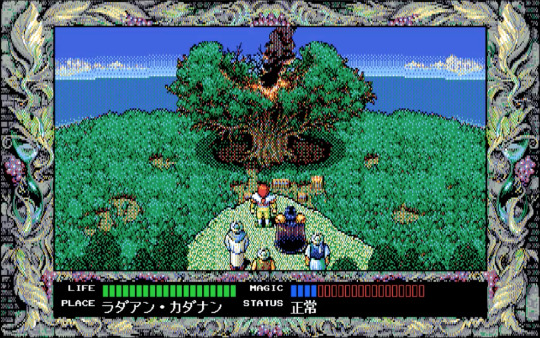

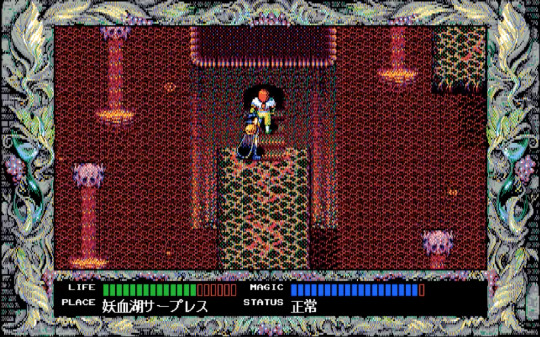
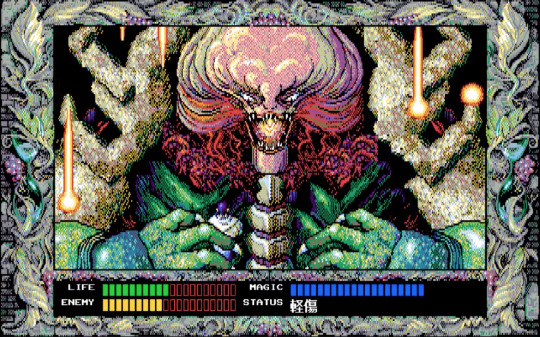
Most English-speaking people today who are aware of videogame developer T&E Soft only know of them through two titles: the first Hydlide (specifically the, by 1987, dated/inferior NES re-release) and Virtual Hydlide. Both of these have acquired a pretty undue notoriety, mostly encouraged by the exaggerations of e-personalities intent on making everything out to be either AWESOME or LMAO TERRIBLE, since that’s what gets the most attention. It’s better to see Hydlide in its PC-6001/PC-88 context as an innovator of the action-adventure-RPG genre, and the influence for the first two Ys games’ format (also little-known: Ys III: Wanderers from Ys was modeled on the design of Tritorn 2, a game by developer Sein/Xain/Zain Soft; it even copied some of the settings!). Understood as such -- compare the PC releases of Hydlide to, e.g., the original Dragon Slayer, also released for the PC-88 in 1984 --, we can also begin to understand its popularity as a consequence of something more than millions of Japanese citizens being deprived and deluded. Virtual Hydlide is noteworthy too as a strange and perhaps unique attempt at crafting a lightly randomized, score- and time-based 3D arcade game for a home console using the overworld + dungeon crawler format. Its most significant downside is a miserable framerate. I get why this would put people off from playing it, especially since it’s always conflicted with the design’s speedrun-like emphases. But if this were the worst thing you could knock a game for, the medium would be specially positioned among all others for a minimum of faults (hint: it isn’t).
With that preamble out of the way, I’d like to bring to unaware readers’ attention Rune Worth 2 and 3, released for the PC-98 in 1991. As usual, if your only resources on the English-speaking Internet for videogames are Wikipedia and MobyGames, you would probably never know about either of these (Wikipedia cites the first Rune Worth (1989) for the MSX, but says nothing of the sequels; MobyGames does not even cite the former). The Rune Worth series was, by all appearances, T&E Soft’s successor to Hydlide, and while it is formally organized as a trilogy, the three-months-gap between the second and third installment’s release, their discounted price, and the way in which 3 picks up right where 2 leaves off (to the extent of being able to transfer your character data from one to the other), means that, really, there are two full entries. Much of this information was laid out on a dedicated stream for both these games by Macaw45, who has dedicated years to researching, cataloguing, and exposing people to lesser-known videogames. If you can’t read Japanese, or just don’t want to play the games yourself, the embedded video would be your best bet for seeing them in action.
There are many things to say about Rune Worth 2/3 -- the dramatic introductory sequence preceding the main menu, the luxuriant sprawl of its public spaces (one can, for example, go out to the first castle’s rooftop, partitioned into a little pseudo maze, despite no requirement for doing so), its equal emphasis on setting, story, and action -- but since I’ve elected to make this into an image-based post, I want to illustrate how amazing these games look. Even from a distance, many PC-98 games have a distinct and highly abstract composure; and, looking at them up close, where the unlikeliness of certain chromatic and textural decisions make themselves known, it’s a wonder over and over again how representation emerges from what I described in a post about Super Hydlide as “an ornate and time-worn carpet.” The resemblance to a tapestry is especially obvious with Rune Worth 3 and its faded floral border depicting a grape vine. The overall visual splendor of these mosaics on a PC-98 monitor would, of course, be all the subtler and greater.
Over time, a handful of early- to mid-90s Japanese PC videogames have gotten more exposure in the West as the consumption of anime and nostalgic sentiment have grown hand-in-hand (not infrequently to pathologically anti-social effect). The bulk of these have tended to be of the visual novel/eroge type. YU-NO: A Girl Who Chants Love at the Bound of this World, released in 1996 for the PC-98, is a particularly popular example, in part because of its soundtrack by Ryu Umemoto. For me, the in-game artwork for these titles can be technically commendable, but is otherwise not very exciting. When I look at Rune Worth 2 or 3, it sometimes reminds me of looking at artist Kathleen Ryan’s beady sculptures of rotting fruit and marveling at the surprising vibrancy and coloristic range within putrefaction: the intersection of the beautiful and ugly, and its fructifying of the grotesque. This extends to a number of PC-88 titles too, like Sorcerian (Falcom, 1987) and DIOS (Zain Soft, 1989). In some cases, there is a remarkable convergence of visual grit/granularity and fidelity, maybe exemplified best of all by the PC-98 release of Xak III: The Eternal Recurrence (MicroCabin, 1993). But even there I find myself missing the marvelous polychromaticism of these two Rune Worth games. The intention for, say, Super Nintendo games to be played and seen on CRT TVs has never been an impediment to contemporary indie developers mimicking their look for modern LCD monitors. Even if it feels unlikely, then, I wonder if we will one day see a small revival of that fibrous, loom-woven PC-88/PC-98 look.
﹌﹌﹌﹌﹌﹌﹌﹌﹌﹌﹌﹌﹌﹌﹌﹌﹌﹌﹌﹌﹌﹌﹌﹌﹌
You can support my writing, music, and artwork on Patreon.
92 notes
·
View notes
Photo










La-Mulana 2 (2018)
Most of the shopkeepers in this game are references to characters from other games, often obscure or Japanese-only releases.
* Enimul is the protagonist of Animal Land Satsujin Jiken.
* Kero is a combination of the lead character from Kero Blaster and Gillian Seed from Snatcher.
* Megarock is quite obviously Mega Man/Rockman, specifically the infamous design used on the cover of the original Mega Man.
* Hiro Roderick is Roderick Hero, the protagonist of H.E.R.O on the 2600.
* Hydlit is visually based on Saitama from One Punch Man, while his name is similar to the early adventure RPG Hydlide.
* Bargain Duck appears to be Scrooge McDuck, redesigned in a more realistic manner.
* The unnamed owner of the Porque Item Shop is the "unnamed female" combined with the pig Butako, both from in Shalom: Knightmare III, .
* Ash Geen is the title character of MSX release Ashguine II.
* Sykick is a notable character (who takes up a goodly portion of the screen at all times) from Cosmic War: Psychic Soldier.
* Venum is Venom, the primary antagonist in Nemesis 2 and Nemesis 3.
* Shuhoka is the ship's doctor in JESUS: Kyoufu no Biomonster.
* Peibalusa is a reference to Pay-Valusa from Tritorn on the MSX.
* Fairylan is based on a fairy from Hydlide III, which was set in Fairyland. (It may also refer to Fairyland Saga.)
* Haja was an unnamed shopkeeper in Miracle Warriors: Seal of the Dark Lord (known as Haja no Fuin in Japan); he only appears in the MSX version.
* Mino the Bomb-Guy is a selectable character in Last Armageddon on the PC Engine and MSX.
* Aytum is a shopkeeper in the MSX version of Xanadu (not to be confused with Faxanadu).
* Korobock borrows his design from a character in Hokkaido Rensa Satsujin: Okhotsk ni Kiyu.
* Pym is Pim, the first shopkeeper in Ys 1: Ancient Ys Vanished on the MSX.
* The Porque shopkeeper is a sort of a double-reference: in the game, the pig Botuko rides about on the lead character's shoulders and provides advice.
Source: Moby Games
(images via Steam Community)
#unofficial#Megaman#Knightmare#Indiana Jones#H.E.R.O.#One Punch Man#Uncle Scrooge#Ys#Gradius#Jesus: Kyofu no Bio Monster#Hydlide
8 notes
·
View notes
Video
youtube
Good Ending
DUSTINODELLOFFICIAL recently uploaded this nearly two-hour compilation of relaxing, downbeat, and chill tracks from Sega Genesis games.
Recorded from Sega Genesis, Model 2 w/discrete YM2512 + line out mods + MegaAmp via Tascam US-1x2 @ 24/44
00:00:00 Valis - Deja-Vu
00:00:54 Arcus Odyssey - Map
00:02:21 Final Zone - After the War
00:06:47 Mega Anser - Bank Menu 2
00:09:05 Light Crusader - Status Screen
00:09:56 Tanglewood - Storm Warning
00:12:32 Batman - Ending Theme
00:15:05 Psy-O-Blade - Be Discared
00:16:18 Harukanaru Augusta - BGM 6
00:17:48 Zoop - Bored Stiff
00:19:55 Crusader of Centy - Burn Daisy
00:22:03 The Pirates of Dark Water - Track 2
00:25:24 Ecco the Dolphin - The Vents
00:26:57 Wonder Boy in Monster World - Under the Ocean
00:28:49 Fatal Labyrinth - Main Theme
00:29:52 Dahna - Continue
00:30:36 Arnold Palmer Tournament Golf - BGM4
00:33:50 Spider-Man vs. The Kingpin - Good Ending
00:35:31 California Games - Surfing
00:38:10 Jennifer Capriati Tennis - Ending 2
00:41:24 Flashback - Sound Test 11
00:44:19 Cannon Fodder - Heroes of War
00:46:44 Shinobi 3 - Ground Zero
00:49:07 Vapor Trail - Staff Roll
00:50:56 Golden Axe - Old Map
00:52:00 Shining Force - Reading Girl 1
00:53:13 Super Hydlide - O.M.I.S.E
00:54:13 Castlevania Bloodlines - The Sinking Old Sanctuary
00:56:16 Shining Force II - Elven Town
00:57:58 World of Illusion - Level 3-1
01:00:26 Columns - Lathesis
01:05:03 Mickey Mania - Garden
01:07:02 Landstalker - A Ballad for Princess Loria
01:09:38 Minnesota Fats Pool Legend - Until Tomorrow
01:12:38 Sonic the Hedgehog - Star Light Zone
01:14:15 Ball Jacks - Ending Theme 1
01:16:02 Wonder Boy III - Big House
01:19:30 Devil's Course - BGM 1
01:22:06 Aerobiz Supersonic - Managing Scenarios 1 and 2
01:23:09 Waialae no Kiseki - BGM 1
01:28:57 OutRun - Last Wave
01:30:50 Monster World IV - Heart of Icegrave
01:33:01 Shanghai III Dragon's Eye - Main BGM (Shanghai)
01:34:16 High Seas Havoc - Sea of Deep Sorrow
01:36:45 Shining in the Darkness - Requiem
01:38:19 Ys III - Sentimental Twilight
01:39:32 Sonic the Hedgehog 2 - Sky Chase Zone
01:40:59 Super Thunder Blade - High Scores
01:42:26 Dynamite Headdy - Ballad for You
01:48:43 Streets of Rage - Good Ending
01:50:58 Ristar - Next Cruise
6 notes
·
View notes
Text
MSX FAN: Akihiko Nagata interview (February 1988)
The following is a translation of an interview with Akihiko Nagata that was featured in the February 1988 issue of MSX-FAN. Nagata-san was a developer within Konami’s MSX department during the 1980′s. This article is mainly focused on the Konami Game Master utility cartridge, known as the Konami no Game wo Jūbai Tanoshimu Cartridge in Japan (literally “The Konami Cartridge That Makes Games Ten Times More Enjoyable”) or the “Jūbai Cartridge” for short. This interview specifically focuses on the enhanced that was released in 1988 known as the Shin Jūbai Cartridge, also known as the Game Master II.
Akihiko Nagata is often credited as one of the original creators of the Akumajō Dracula, although in reality he only worked on the MSX2 version (released in Europe as Vampire Killer) and not on the original Famicom/NES game, although he would later become an executive producer in many titles, most notably the PC Engine version of Snatcher, as well as Policenauts and the original Metal Gear Solid.
Introduction
We wondered why kind of developers are the people behind Konami who put hits after hits such as Shalom and Salamander. We did a direct interview with Mr. Akihiko Nagata to find out.

Mr. Akihiko Nagata is the supervisor who leads the PC department in Konami’s development headquarters. He is 28, unmarried and currently resides in Hyogo. His hobby is work. He was busy during this day, attending this interview and a party.
Secret History of the Game Master
MSX-FAN: The Game Master 2 was released last January, but the original Game Master was already something of an unusual software. For starters, it’s not a video game at all.
Nagata: That’s because the Game Master is a software we used to test out games during development. It was a software that we made out of necessity for development. It was pretty easy to make it into a retail product. No development costs were necessary, it was simply a matter of putting it together. (laughs) The hardest part was trying to make the Game Master compatible with the games that were released before it. So when it came to the older games, we had to insert many programs for each of them. The next obstacle after that was trying to make the Game Master compatible with all MSX models with a second cartridge slot. That was truly difficult.
Speaking of which, the usage and functionality of the original Game Master differs when played on MSX2-specific games.
It couldn’t be used to import screen data or to create save data [on those MSX2 games]. The Game Master was also required to be on the second cartridge slot [as opposed to the first slot]. Because of this, the Game Master 2 not only has the same usage and functionality as the original Game Master, but it can also be used to record screen data and game progress on MSX2 games.
It seems that you can save your progress using S-RAM.
We added 8-kilobytes of S-RAM in order to make saving progress convenient. You can save your progress on the Game Master 2 or on a disk with around 2 key inputs.
That sounds convenient for RPGs and Adventure games. So does that mean we’ll be seeing more of those type of games?
We have many requests for such games. I would like to make a game that could becoming a series like Dragon Slayer or Hydlide, but I would also like to develop a software that could create a sense of unity between the player and the game and of course, have a Konami-like sense of action.
Games Born From The Game Master
There are Konami games that make use of the MSX’s second cartridge slot for interesting features. For example, you can turn the Vic Viper in Gradius [released as Nemesis in the UK] into the titular ship from TwinBee.
When we were working on Gradius for the MSX, the neighboring Famicom division were working on Moero TwinBee [released on the NES as Stinger in North America], so we’ve tried putting a side-way TwinBee for a bit in the game. It turned out to be fun and that’s how it ended up being.
Have you created such games while thinking about using the second cartridge slot from the outset.
It was planned from the beginning with Gradius 2 [aka Nemesis 2] and Salamander [note: the MSX version of Salamander has a secret ending that requires you to clear the game with a Gradius 2 cartridge on the second slot], but usually we put such features in a game just before it goes into mass-production in around a day.
Finally, which was the game that gave you the most concern?
Naturally it was a game that didn’t sell well, but it’s difficult to describe what kind of game it was. (laughs) For instance, it was a game that was described by a certain publication as a “Konami-like shooting game”. I will leave it to your imagination to figure out which game it was.
I’m sure we can rely on Konami for making fun games. Thank you for taking your time today.

Akihiko Nagata with Konami spokeswoman Akemi Kamio holding a copy of Salamander for the MSX.
6 notes
·
View notes
Text
Okay I've finally fully completed Fairune Collection outside of two achievments in Fairune 2 and a couple in Fairune Blast. Unrelated to my review of these games I wanna coin the term Hydlike, even though i think Xanadu did bump combat first. But I could be wrong I havent eaten yet today
Fairune 1 and 2 are really wonderful little games that alternate between making you feel really smart and really dumb. Every so often they make you want to email the level designer to tell them you disagree. But they're really great. I guess I should only say Fairune 1 is a "little" game though. The sequel is massive by comparison. With a little help from gamefaqs the first game took me just over 2 hours, and the second game took 6 hours and 40 minutes
As for what they actually are, they take heavy inpiration from Hydlide in the way you transition screens, the way enemies spawn in, the bump combat system, and the first games entire UI. One of the things I prefer about the first game is that since it was on the 3DS and used the touch pad for things back then, it transitioned really well to the old style RPG screen layout with the game in a little box on one side, and your map and items on the other. Fairune 2 looks more like a normal modern kind of RPG, but it needs to because of its scale compared to the first game. Gameplay consists of walking around to find items to progress, but walking around means looking for hidden walkways and switches and stuff, some of which are muuuuch more obvious than others. Most of the puzzles are very good. There's a few that are so obtuse you'd have to literally rub up against every wall in the whole map to stumble upon it, but that's absolutely in the spirit of its source material. Hydlide and Xanadu are nightmare games for insane people by modern standards. But Fairune 2's final puzzle is so good I will probably never speak of it to anyone who doesnt know. Its your reward for figuring out the block puzzle at the top of the tower with the logs
Fairune Origin is a strange mini game-ish version of the concept of the other games. I honestly dont know how to describe it. Its the same experience condensed into a 6 minute long little speed game thing. The world record is around 4 minutes. Its neat tho. And Fairune Blast I believe was new for the collection and its a shmup that includes characters from Kamiko which Skipmore also made. I'm slowly getting more into shmups because of Silpheed (yeah I know thats fucking weird) but this feels like a good one. It feels short which means you can just play it for a little bit then do other stuff with your day. And it features all your favorite Fairune tm characters
Im gonna go back and do Fairune 2 in under 3 hours for the chievo, but generally i think I'm gonna revisit the first game the most, because the first game is a 45 minute experience if you remember where to go. Origin is a 5-ish minute experience, a run of blast takes like 3. Fairune 2 is an incredible game that idk how many times I can handle running cuz it uses all of my brain juices to remember where to go even after opening shortcuts. But at minimum I have two runs left to do and I'm looking forward to them regardless. Very good collection, would recommend
0 notes
Video
youtube
DAY 1283) Virtual Hydlide - Volcanic Cave
Composer: Yumi Kinoshita
Starts in 4/4 but goes into 7/8 at :35. The 7/8 section ends with an extra 2 8th beats just before :56, then it goes back into 4/4.
#vgm#video game music#virtual hydlide#time signature#irregular time#irregular meter#irregular time signature#odd time#odd meter#odd time signature#uncommon time#uncommon time signature
2 notes
·
View notes
Text

Florida has had its clouds permanently revoked
Our mushrooms were going bad so I made some big udon before work and it was actually real good. Then I played a little of Side Order before I left and i had forgotten that a lot of why i played so much of the single player in 3 was because the game looks and runs a lot better offline lol. I only did the first 10 tutorial stages but I like what i'm seeing so far
I had a lot of down time at work and I spent a ton of it trying to beat the next to last boss in Onimusha without healing or upgrading weapons health or magic, and i'm getting better but this is a stupid ass challenge I have set upon myself. But if I decide to do one of those things to win then I have to beat the final boss without the broken Bishamon sword like 3 times and that sounds maybe worse. I turned on Hydlide 3 also and the music in that is so fuckin good. I dont think I will ever complete that game but I have so much love and respect for it. Its kinda funny that I feel the same way about Hydlide 1 and 3 as I do about Fairune 1 and 2. Where both of the first games are exactly what I want from their concept, and then the sequels are like the same but too much. Fairune 2 is much normaller and more approachable than Hydlide 3 though
My Kanji of Da Day is actually two kanji, but the two combined are less complex than 願. I learned 今 and 晩, as in 今晩は. Remembering that ha becomes wa at the end of words is very strange to me but I'm sure theres a good reason for it


Peace and Long Life
3 notes
·
View notes
Text
Completed - Dragon Warrior (Dragon Quest 1)
No more janky TV photos. Just a janky GIF.

I don’t think it would come as a shock to any of you that I enjoy a good amount of Twitch. Like, finally sacked my cable subscription because all I watch is YouTube, Twitch, and Pluto.TV. Now, my streamers of choice are either GDQ participants, Kusogrande hosts, or people who are otherwise mellow while grinding to get milliseconds off their PBs. As a result, I was spending a fair amount of time last month watching NESCardinality plug through "Dragon Warrior" randomizer runs. (Which, if you haven’t seen his GDQ run of "Dragon Warrior", you should. Because holy shit, the level of RNG manipulation going on in that is phenomenal.)
Here's the thing, though—I hadn’t beat the game myself. At least, not until recently.
Any cursory knowledge into JRPGs will easily bring up the "Dragon Quest" series. There’s a lot of repeated anecdotes, regarding it. It’s Japan’s favorite RPG series. When one comes out, a significant amount of people take the day off. It’s got art by Akira Toriyama and music by an absolute shithead. Slimes. And…is that it?
Playing the game itself, it’s not immediately evident why "Dragon Warrior" didn’t catch as much fire in the US as a series like "Final Fantasy." (Maybe "Persona" in the modern era.) It’s not like "Hydlide", where eye-searing graphics, a single poorly-looped song, and obtuse mechanics doomed it to Funcoland reject stands. "Hydlide" may be apropos as a comparison game in one distinct way, however. Both "Dragon Warrior" and "Hydlide" were originally adapted for the Famicom in 1986, with "Hydlide" having earlier PC incarnations before that. The US adaptations of these games came out in 1989. Those titles were competing with the likes of "Mega Man 2", "Ninja Gaiden", "The Adventures of Bayou Billy", and "Faxanadu." That’s like putting Byzantian cave scribblings of Christ next to the works of Italian Renaissance artists.
Plus, let’s face it. The average Nintendo Entertainment System gamer at the time was either:
10 and under, or…
Let’s just say, not capable of playing something that required more thought than moving to the right and shooting/jumping over things.
The big saving grace for "Dragon Warrior" came from a brilliant promotional idea. With a load of extra copies of the game on hand, Nintendo decided to give them away as a bonus for subscribing to "Nintendo Power." Big dick energy. I mean, I know a lot of modern-era services give a game away a month for subscribing to them, but to have something physical back in the early 1990s? That was pretty cool. Cooler than burying the unsold extras in a desert, anyway.
With games of this age, I do like to try playing them knowing only what’s given to me in materials enclosed with the game. Ya know. Feel what the pain was for the kids at the time. So, I downloaded the game’s manual and poster, then gave it a shot. With those limitations in mind, this game does surprisingly well! The manual’s author was really doing their best to help babies through their first RPG, and the map was helpful in figuring out pathing and grind spots. (Oh, and also advertise a little for "Dragon Warrior 2." Nudge nudge, wink wink, right?) Even if I didn’t have that, the game is clear enough to make objectives known. Granted, there’s a fair amount of fetch questing to be done, so it doesn’t hurt to have a pad of paper at hand to take notes.
I highly disagree with the manual writers on one thing, though. Saving the princess does not have to happen at level 12. Frankly, with the bullshit around her and with what little she provides in gameplay value, you might as well save that task for after getting Edrick’s armor.
Who is Edrick?
Uh…guess I should start with a plot summary, huh?
So, a while back, this dude named Edrick (or Loto, or whatever the translation picks in your version) brought peace to the land of Alefgard with a shining ball of light. Some territories need four balls of light; Alefgard was good with one. But, ya know. Peace doesn’t last forever. So, when the ball of light and the kingdom’s princess are nicked by a dork calling himself the Dragonlord, monsters start pushing everyone’s shit in. Despite no proof (yet) of your heritage, you set out with the king’s blessing to collect Edrick’s treasures and stab anything that looks at you funny. Maybe keep an eye out for the princess. Standard hero stuff.
I’m not gonna lie. There was this initial wave of dread I felt after my first battle with a Slime. 1 gold, 1 EXP. You wanna know how rough that is? A stay at the first town’s inn? 6 gold. A single healing herb? 24. A copper sword? 180. Like, fuuuuuck. Granted, the economy gets a little better once you can push past the first area, at least in terms of housing. It goes from needing 6 battles minimum to rest to 2 battles. Still, the economic crunch is real. God help you if you screw up without saving for a while, too. The king needs tax money, and apparently, he’s getting that by yanking half of your cash off your corpse.
Granted, the steep economy also unconsciously gives the player a good incentive to grind. So, that’s some okay game design. I also like how the game plops you outside of town and flashes the final game’s dungeon in the corner, like "Hey, idiot. Figure out how to go here." Good stuff! Even the battle system becomes smoother, once you figure out what the monsters know and what you can do. Stopspells for magical bastards and Sleep for heavier hitters go a long way. Just don’t be surprised when the game gets rude. Critical hits and enemy dodges are calculated separately, so I saw a few dreadful "Excellent move! The enemy is dodging" messages chains. I also had a Red Dragon that decided I had gone far enough into Charlock and decided to take a pre-emptive turn, put my dude to sleep, and take him from full health to nothing in four or five swings. Just real cool. The coolest.
Speaking of messages! The translation in this game is weird, to say the least. It’s trying to lean into a "Ye Olde English" pronoun/verb set that goes very thick. Like, dragging damage numbers and rewards several lines down in the textbox area thick. I’d imagine that would be really irritating if English wasn’t your first language. Style can be helpful for world building, but brevity wit etc.
Despite the game’s age, several changes were made for the U.S. release to help it out. There’s a graphical overhaul that might not be appreciated in game, but it is pretty evident in comparisons with the original Famicom version of the game. I still prefer the "Final Fantasy" battle layout and artistic style better, but the effort did help spruce the game up. It also has an internal battery for saving instead of a password system, which is great for children in 1989 but maybe not for adults in 2022 that are struggling with a dying battery. If you were wondering what dickhead in the world likes passwords over internal saves, congratulations! You found me!
I’m just saying—if I didn’t have access to a dude that knows how to resolder shit, I’d be in trouble. Like, there are circumstances where passwords get stupid long or unwieldy, but I’m not opposed to a decent password system for simpler games. Also, I’m sorry to report that your "Pokémon Gold", "Silver", and "Crystal" saves are all gone now. GBC-era batteries just weren’t meant to keep time for over 20 years.
One thing that surprised me about my mindset during this game is how many alternate scenarios kept going through my head. Like, 2010s dark fantasy scenarios. Maybe it was a reaction to the cutesy monster art and vanilla-sweet story? Or, maybe I was thinking about the "Nanashi no Game" series and how that’s all about corrupted "Dragon Quest" styled games? Just saying. There’s a lot of potential possibilities for something to go wrong here. Like:
So, it’s nice that the king resurrects the player. But, at half his gold, no matter the cost? Imagine what it would be like to be a citizen of Alefgard, in such circumstances. Who does the king decide to bring back, and why? Could he keep an army of resurrected guards for all eternity, as long as he keeps getting their bodies back? What about the peasants? Are they destined for eternal work and poverty? How do you handle the king deciding not to bring your mom or grandma back? What’s exactly the limitation of his power, here? Somebody’s sword in his chest?
The hero is constantly being badgered to prove his worth not through his actions, but his bloodline. Doesn’t that shit get old? What happens if someone else takes that token of truth first? (Yeah, yeah, "Chrono Trigger" fans. Settle down.) He wants to colonize his own land, but what does that look like? Taking over Charlock? Going further and never coming back? Does he perpetuate the bloodline bullshit, or does he go democratic? Does he ever think of going back and getting his money/vengeance from the king, or is taking his daughter revenge enough?
You can decide to not save the princess. It’s totally doable. She only helps you find Edrick’s Token, and that’s always in the same place. What happens, then? How is she not blind and mentally disturbed from being held captive for months in a dark cave? What does she do if the Dragonlord dies, but nobody goes to find her? What does the dragon guarding her do? Does it lose heart? Does it bond to her? Does she become the next Dragonlord?
I mean, I’m not alone in thinking of these things. "Dragon Quest Builders" is basically asking that question. Well, in the more basic "What if the hero had taken the Dragonlord’s offer?" way, but still. Someone else was thinking about it. Someone was also trying to get some of that sweet, sweet "Minecraft" money too. The spirit of Taloon lives on.
If you’re interested in gaming in a historical sense, then "Dragon Warrior" can’t be passed up. The circumstances around the game are still influential for JRPGs, particularly in Japan, so it may be helpful to understand where the "Dragon Quest" series started and why it became successful (even if it was a bit by force.) It’s also a cheap game to get a hold of, both digitally and physically. At least, better than most NES RPG prices tend to be.
You do have to be patient with grinding, however. Also, I’d classify this as a podcast game. Ya know, something you play while you have the audio muted and other audio playing on another device. A weird call? Maybe. I mean, the intro theme is good, but a lot of the music is otherwise a set of short loops with mediocre scoring.
…You’ve really, really got to be careful when you make the triangle channel a lead in an NES song. I’ve only heard it work, like, once. It’s got no volume control, man. The sound’s either on or off. Very unnatural. Annoying when it goes too long.
0 notes
Photo










Noriyuki Moto / もとのりゆき - Part 1: 1986-1991
http://moto-noriyuki.com/
Former Osamu Tezuka collaborator, mostly known in the video game industry for his Falcom game illustrations.
Part 2:
http://videogamesdensetsu.tumblr.com/post/172342158650/noriyuki-moto-%E3%82%82%E3%81%A8%E3%81%AE%E3%82%8A%E3%82%86%E3%81%8D-part-2-1992-1995-misc
Games featured above:
1) Taiyō no Shinden: Asteka II / 太陽の神殿: アステカ II (PC-88 - 1986) promotional illustration
2) Romancia / ロマンシア (PC-88, PC-98 - 1986) promotional illustration
3-4) Ys / イース (1987) cover art, promotional illustration
5) Sorcerian / ソーサリアン (PC-88 - 1987) promotional illustration
6) Ys II / イースII (1988) promotional illustration
7) Star Trader / スタートーレーダー (PC-88, PC-98 - 1989) promotional illustration
8) Ys III: Wanderers from Ys / イースIII ワンダラーズフロムイース (PC-88, PC-98 - 1989) cover art
9) Yōkai Henkikō: Last Armageddon Bangaihen / 妖怪変紀行 ラストハルマゲドン番外編 (MSX2 - 1989 - unreleased) promotional illustration
10) Slime World / スライムワールド (Mega Drive - 1991) Japanese cover art
Games he has worked on:
Fixeight (Arcade - 1992) flyer illustration
Kaze no Densetsu Xanadu II / 風の伝説ザナドゥII (PC Engine CD - 1995) cover art
Romancia / ロマンシア (PC-88, PC-98 - 1986) promotional illustration
Slime World / スライムワールド (Mega Drive - 1991) Japanese cover art
Sorcerian / ソーサリアン (PC-88 - 1987) promotional illustration
Star Trader / スタートーレーダー (PC-88, PC-98 - 1989) promotional illustration
Taiyō no Shinden: Asteka II / 太陽の神殿: アステカ II (PC-88 - 1986) promotional illustration
Yōkai Henkikō: Last Armageddon Bangaihen / 妖怪変紀行 ラストハルマゲドン番外編 (MSX2 - 1989 - unreleased) promotional illustration
Ys / イース (1987) cover art, promotional illustration
Ys II / イースII (1988) promotional illustration
Ys III: Wanderers from Ys / イースIII ワンダラーズフロムイース (PC-88, PC-98 - 1989) cover art
To be confirmed:
Gegege no Kitaro / ゲゲゲの鬼太郎 (mislabeled illustration)
Hydlide / ハイドライド (listed on his profile. Might be the PC version of Hydlide I or III)
SD Gundam Entaku no Kishi / SDガンダム 円卓の騎士 (listed on his profile)
Yoshi's Island / ヨッシーアイランド (listed on his profile)
Popful Mail (PC-88, PC-98) illustration
Other video game-related works:
Oh! X (magazine) cover illustrations (September, October 1989)
Xanadu Densetsu Osamu hōken / ザナドゥ 伝説乃宝剣 (Board game - 1987) cover art
Sources:
Falcom Chronicle (Asteka II, Romancia, Ys I-III)
Falcom Special Box '89 (Asteka II, Romancia, Ys I-III)
Falcom History: Legend of Illustrations (Star Trader, Ys I-III)
Yōkai Henkikō: Last Armageddon Bangaihen:
https://middle-edge.jp/articles/znuNr
115 notes
·
View notes
Text
2019 Mega Drive Explorations [1]
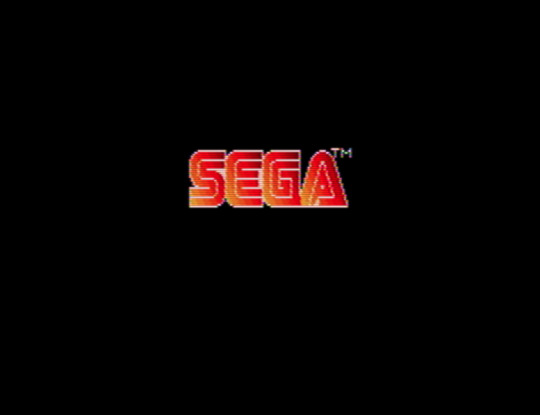
It takes me a long time to do some things and I’ve finally gathered up a bunch of Sega Mega Drive / Genesis titles that I’ve been meaning to play, hopefully through their entirety, or replay and take as many screenshots as I can. These aren’t going to look like most other screenshots you’ll see online, though; I’ve been using an NTSC filter because I believe it’s the visual format in which these games look best. So, let’s take a stroll through the material so far.
Super Hydlide (1989)

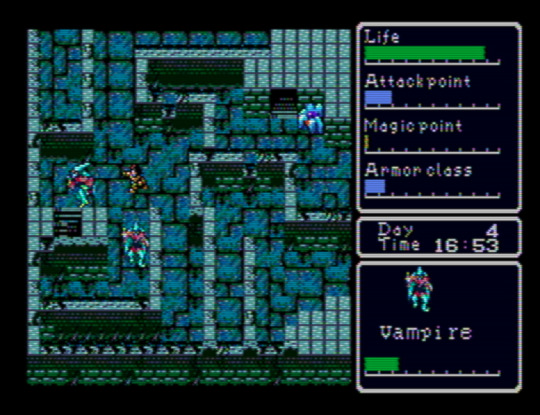
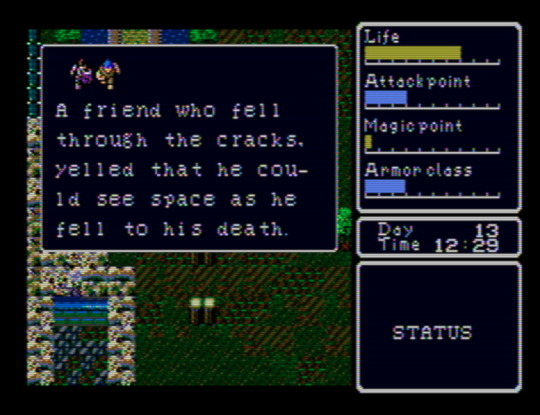
This is one of the best “old style” action-RPGs I’ve played. I’ve gone in with barely any prior knowledge, and I think that’s how to best experience it. Spoiling yourself on the extent and workings of its mechanical systems would, I think, turn it into nothing more than leveling up and finding the next place to go. The range of overworld which you’re initially able to explore is fairly restricted, and, as the action-RPG designation suggests, there are no randomized battles. Because of details like your need of food and sleep, or the encumbrance limit, though, it’s a deep relief to return to a town after some exploration in a way that reminds one why this trope of wilderness vs. domesticity caught on. You might just find yourself exhaling when your enter an inn. In another game, your character’s attack would likely be assigned a hitbox straight ahead of the sprite, but Super Hydlide locally assigns it to your right arm/hand, and it’s a welcome quirk in a game with super basic combat. There is no in-game map (or, if there is, I haven’t found it yet), and so -- as with Simon’s Quest -- I’ve been drawing my own on a sheet of gridded paper.
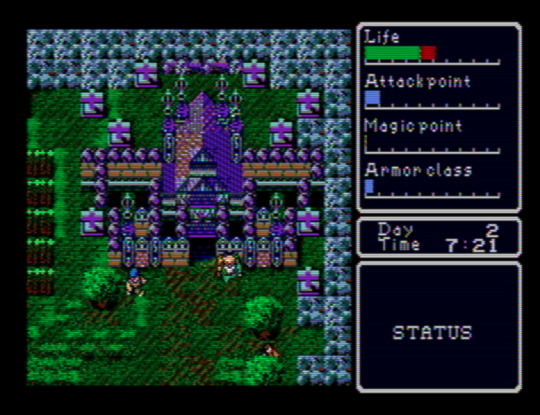


Above: the same screen at different times of day.
I hope that this blog’s emphases and its audience make the claim that I think Super Hydlide looks amazing at least appreciable. Everything has just enough detail to render the object, being, or space as categorically legible while retaining ambiguities, and there’s a variety where you might not expect it, like the grass around the building above, that gives each screen a kind of visual grain that an ornate and time-worn carpet might have. Complementing this is a soundtrack that seems unaware of the console’s audio capabilities in a way that another contemporary Mega Drive release, like Sword of Vermilion, certainly was not. That’s fine, though; the sound’s smallness, with those lite approximations of exclamatory synth brasses and the percussion’s dusty, dinky punches, enhances the cute visual aesthetics: people, monsters, and buildings you could hold in a pair of cupped hands. Especially remarkable is the overworld theme, “Chaos Separator” -- almost three minutes long, a duration that was basically unheard of at the time.
Atomic Runner Chelnov (1992)

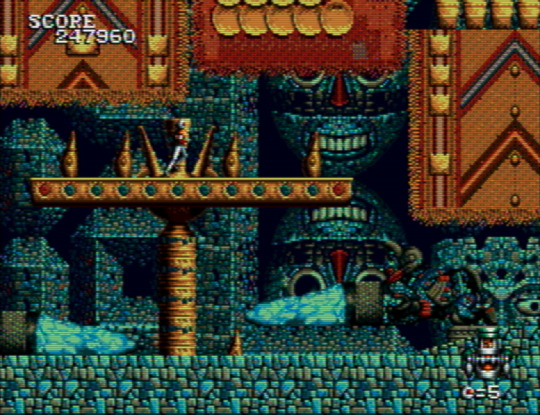
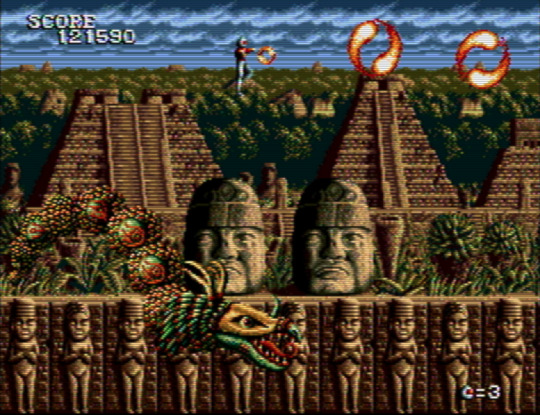
Chelnov has me torn between wanting to share either as many screenshots of it as I can or as little. It’s so stunning to behold that exposing anyone who hasn’t played it to its sights seems like a disservice. It’s in extreme contrast to the game’s original arcade version, too, which may as well be a different game. Every stage is a stream of layered ornaments, and continuing to play to see more of this is motivation alone. At first I thought the graphic theme was one of a general “exoticism”, with ziggurats settled above lava giving way to stepped Mayan pyramids, but then the penultimate stage threw architecture designed by Antoni Gaudí my way, making me wonder if the theme is more broadly “eclectic” -- choosing certain settings and motifs for their dazzling power alone. This is one of those run ‘n’ gunners where your character will keep running unless you stop them -- but you soon have to start running again anyway, since the screen keeps moving right and only stops for bosses. It took me playing through half of the game to figure out how to turn around. Please, if you want to give Chelnov a look: consult a controls FAQ.
El Viento (1991)
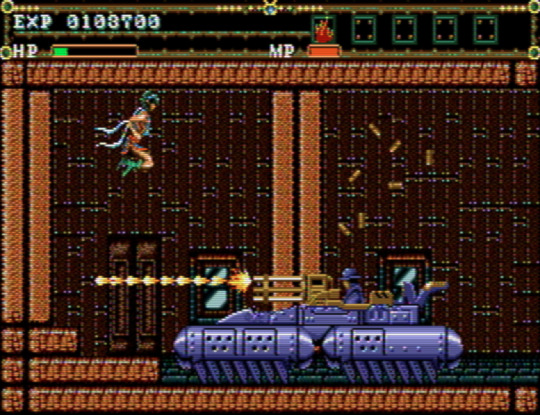
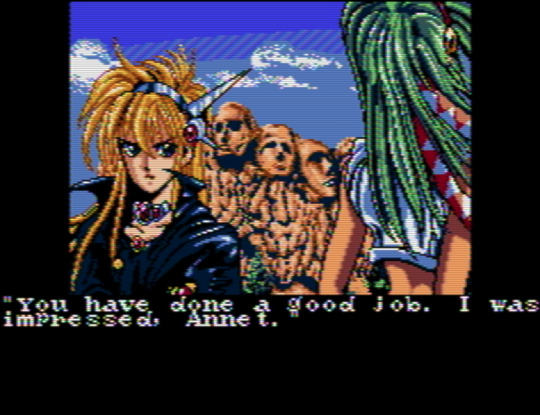

If you’re looking for level design that’s a mixture of the mundane and the out-of-control, El Viento might be for you. One moment you’re walking through an open sewer channel, exploding the occasional fish; the next, you’re navigating a bundle of platforms that feel way too closely packed together for your character’s sprite size as you attempt to outrun a never-ending flood of rats that move at speeds never before recorded. One moment you’re going through an apartment’s door into an empty interior; the next, a tank bursts through the opposite wall and just starts hammering you with missiles and bullets, giving you only five feet of space to work with. It’s the second in a trilogy of games, which includes Earnest Evans, a game perhaps most notable for all of its footage making it appear that the players are incompetent on purpose, but which in fact plays more or less the same no matter how good you are. Grave sacrifices were made so that the titular character could be a composite sprite. El Viento’s level design hews closely to Earnest Evans’, with the important difference that its protagonist, Annet Myer, is controllable.
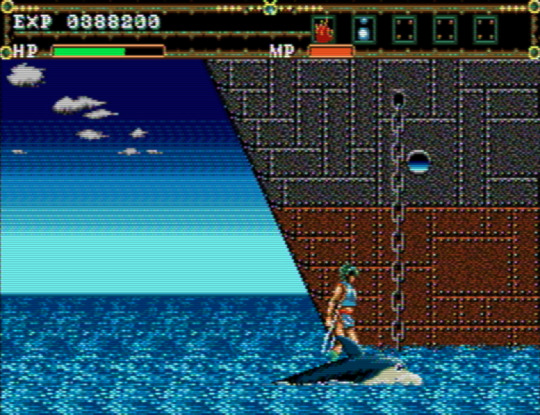
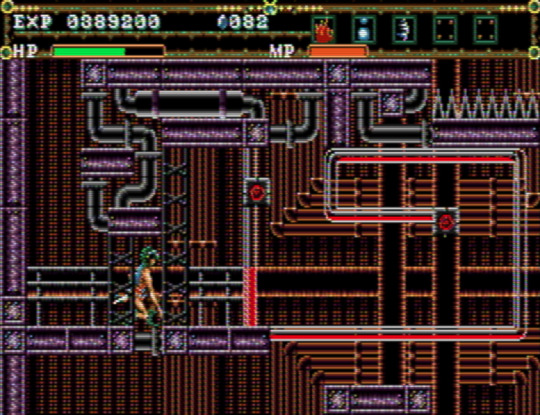

Even with its problems, El Viento is charming. It’s nice to play a videogame with a female protagonist who’s not creeped on by the artist(s) (perhaps we can, in part, thank technical limitations for this). The palettes and style of pixel art bear an uncanny resemblance to Master of Darkness, released for the Game Gear and Master System, and give each stage a distinct, almost dirty granularity. For me, El Viento gets especially interesting around the fourth stage, a ship’s engine room (or... factory?) that’s preceded by a short segment that has you crossing water on top of a cartoon-eyed dolphin. The level design transitions to looking like a network from Metroid Fusion -- a knotty maze with small destructible points that cause chain reactions, oddly small platforms, moments where you’re not sure what’s interactive and what’s not, and low ceilings underlined by spike-beds that necessitate you make use of a crouch-dash mechanic that feels like it shouldn’t work the way it does. It’s a hardly perfect yet precious occurrence of extinct, or endangered, level design, and the developers apparently had a confidence in letting it, as it were, speak for itself, because there’s not a single enemy to defeat throughout.
Jewel Master (1991)
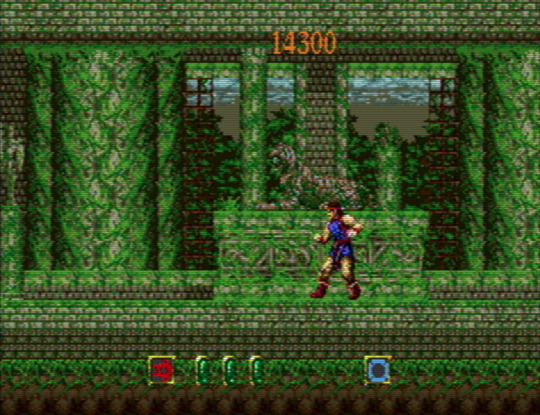

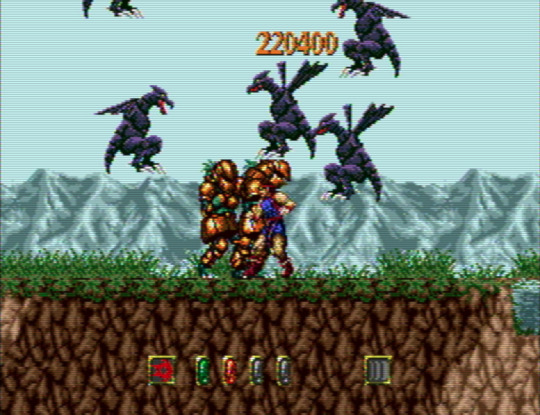
Wanting to hear Motoaki Takenouchi’s incredible score, one of the Mega Drive’s best, in its intended context was almost totally my incentive to play Jewel Master. It’s a fine, somewhat haphazardly designed action game; not bad, not memorable, but for the music. You acquire different rings, some optional, as you go from stage to stage, and can assign them to a total of four active slots on an equipment menu. Different combinations will lead to different effects -- or you might want to leave a ring on one hand on its own. It’s a neat idea in the abstract. In practice, you’ll often be better off sticking to one set-up per stage until a boss demands a switch. The level design is pretty uninspired, and it increasingly makes artificial attempts at challenging the player by burying you under swarms of suddenly-appearing monsters. When this happens, you just have to hope that you can make it out alive. There’s not a whole lot to look at, either: the stages’ environmental peculiarities and palettes are minimal to an extreme, although I do love that the protagonist’s sprite seems to take a cue from Rastan’s by only moving his legs when he walks.
Gynoug (1991)
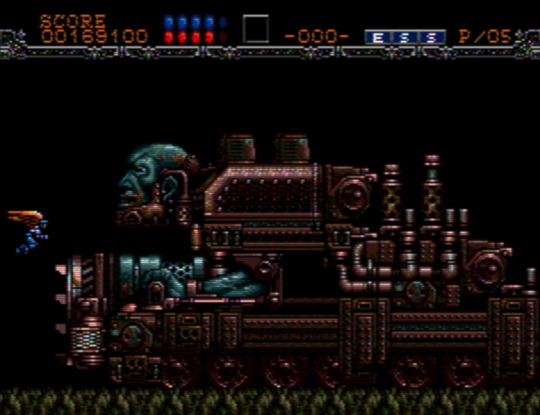
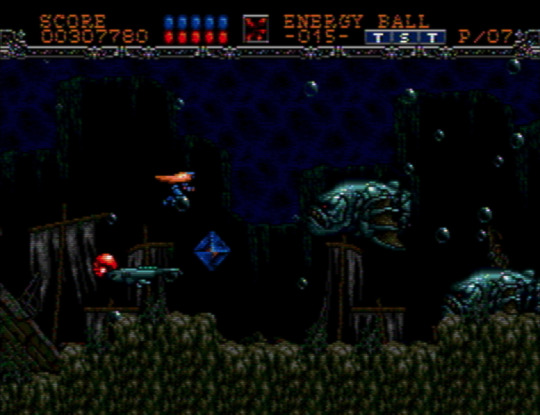
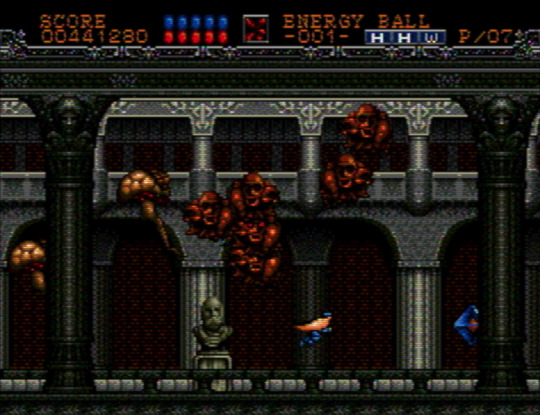
My experience with, and interest in, shumps, is next to nonexistent, so I don’t have a ton to say about Gynoug. Why’d I bother? Well, because of the weird and grotesque enemy and boss sprites, which combine the mechanical, exoskeletal, and visceral. The first miniboss is like a floating snapping turtle... except without legs, and a head that’s a toothed skull. Later, in stage two, you’re confronted by the bow and head of a ship that reveals itself to be the hat atop a colossal, wrinkled face. Maybe it was expecting too much to hope that the settings would match the bestiary’s inventiveness, but only stage three and four wowed me. If it’s not a game I’m going to be returning to any time soon, it was worth going through once.
That’s all for now. Other titles I’ve been exploring and will write about at some point include Alisia Dragoon, Cadash, Chakan: The Forever Man, Elemental Master, Light Crusader, Mazin Saga: Mutant Fighter, Mystic Defender, Shining Force 2, Splatterhouse 2 and 3, Two Crude Dudes, and Ys III.
14 notes
·
View notes
Video
youtube
Tomb Raider Games - Angry Video Game Nerd (Episode 159)
Huh, a new AVGN episode? Over the span of two weeks, even? Wow... uh... okay... Spoilers, I guess...
>I’m sad that James’s face shopped onto Lara’s body wasn’t the thumbnail.
>...Hydlide theme... urgh...
>...I personally have only owned one Tomb Raider game personally as a kid. It was “The Prophecy” for GBA. I had no idea how to play it, so I couldn’t even get past the first level (even now, I still haven’t beaten it. Seriously, password systems should’ve died when GBA came along). I was relegated to just watching my mom play the games, as I was an easily scared little kid. Besides, I had Mario and Sonic (among a few others) to keep me company, and when I was “old enough” to play the games (by ESRB standards anyway), I was already in my first year of high school and pretty set in my ways.
>...huh... I wonder what the other games besides the SquareEnix games, the first four titles, and “The Prophecy” were like? ...judging by James’ tone... not so great. Look at that, he’s already packing up to destroy them! Jesus, even Homura Akemi had less fire power!
>Man, I forgot how much I love these special effects. The polygon model statues were pretty neat, but the shark had me laughing.
>Oh right. Lara died. Huh...
>Man, product placements... it’s like the Lifesavers in Croc 2. At least Pikmin 2 did it really well. Oh, and uh... be sure to drink your Hetap!
>How has Lara not been arrested for murder yet?
>Wow, you know a game is shit when a developer says so.
>The Angel of Darkness... oh, that’s... not boding well...
>Ah, so it’s a trial-and-error type game?
>Lag and limited visibility... what a fun combination!
>Oh, jiggle physics! How arousing! Too bad it had to come at the cost of a good fucking game!
>This incarnation of Paris is as barren as the Nazi occupation!
>I WANT THIS GAME TO TAKE A LOAD IN ITS MOUTH!
>”Leave me alone, I’m busy!”
>Earth Wind Water and Fire...
>Wow, playing as this guy is just like playing as Shinobu in No More Heroes 2... only way fucking worse.
>The Last Crusade comes to a close.
>...Holy shit... Nokia made a handheld? I didn’t expect that...
>...the Nerd needs to get more friends.
>Oh hey, “The Prophecy”!
>The dragon is busy.
>FUUU FUUU FUUU FUUU FUUU FUUU FUUU FUUUCK!
1 note
·
View note